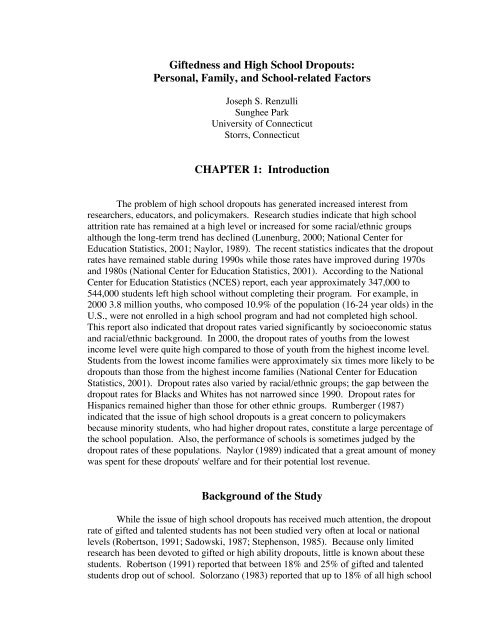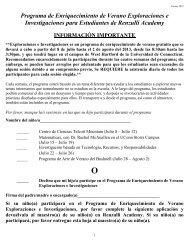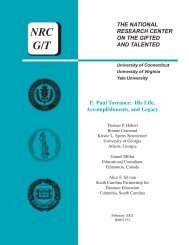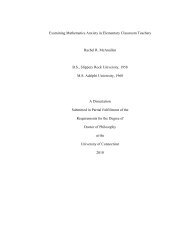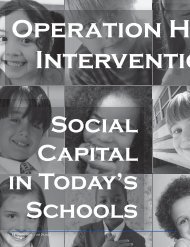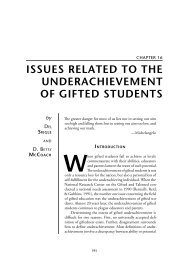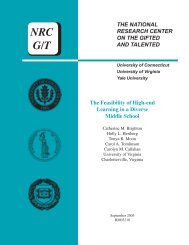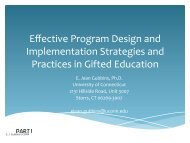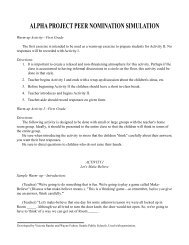Giftedness and High School Dropouts - Neag Center for Gifted ...
Giftedness and High School Dropouts - Neag Center for Gifted ...
Giftedness and High School Dropouts - Neag Center for Gifted ...
Create successful ePaper yourself
Turn your PDF publications into a flip-book with our unique Google optimized e-Paper software.
<strong><strong>Gifted</strong>ness</strong> <strong>and</strong> <strong>High</strong> <strong>School</strong> <strong>Dropouts</strong>:<br />
Personal, Family, <strong>and</strong> <strong>School</strong>-related Factors<br />
Joseph S. Renzulli<br />
Sunghee Park<br />
University of Connecticut<br />
Storrs, Connecticut<br />
CHAPTER 1: Introduction<br />
The problem of high school dropouts has generated increased interest from<br />
researchers, educators, <strong>and</strong> policymakers. Research studies indicate that high school<br />
attrition rate has remained at a high level or increased <strong>for</strong> some racial/ethnic groups<br />
although the long-term trend has declined (Lunenburg, 2000; National <strong>Center</strong> <strong>for</strong><br />
Education Statistics, 2001; Naylor, 1989). The recent statistics indicates that the dropout<br />
rates have remained stable during 1990s while those rates have improved during 1970s<br />
<strong>and</strong> 1980s (National <strong>Center</strong> <strong>for</strong> Education Statistics, 2001). According to the National<br />
<strong>Center</strong> <strong>for</strong> Education Statistics (NCES) report, each year approximately 347,000 to<br />
544,000 students left high school without completing their program. For example, in<br />
2000 3.8 million youths, who composed 10.9% of the population (16-24 year olds) in the<br />
U.S., were not enrolled in a high school program <strong>and</strong> had not completed high school.<br />
This report also indicated that dropout rates varied significantly by socioeconomic status<br />
<strong>and</strong> racial/ethnic background. In 2000, the dropout rates of youths from the lowest<br />
income level were quite high compared to those of youth from the highest income level.<br />
Students from the lowest income families were approximately six times more likely to be<br />
dropouts than those from the highest income families (National <strong>Center</strong> <strong>for</strong> Education<br />
Statistics, 2001). Dropout rates also varied by racial/ethnic groups; the gap between the<br />
dropout rates <strong>for</strong> Blacks <strong>and</strong> Whites has not narrowed since 1990. Dropout rates <strong>for</strong><br />
Hispanics remained higher than those <strong>for</strong> other ethnic groups. Rumberger (1987)<br />
indicated that the issue of high school dropouts is a great concern to policymakers<br />
because minority students, who had higher dropout rates, constitute a large percentage of<br />
the school population. Also, the per<strong>for</strong>mance of schools is sometimes judged by the<br />
dropout rates of these populations. Naylor (1989) indicated that a great amount of money<br />
was spent <strong>for</strong> these dropouts' welfare <strong>and</strong> <strong>for</strong> their potential lost revenue.<br />
Background of the Study<br />
While the issue of high school dropouts has received much attention, the dropout<br />
rate of gifted <strong>and</strong> talented students has not been studied very often at local or national<br />
levels (Robertson, 1991; Sadowski, 1987; Stephenson, 1985). Because only limited<br />
research has been devoted to gifted or high ability dropouts, little is known about these<br />
students. Robertson (1991) reported that between 18% <strong>and</strong> 25% of gifted <strong>and</strong> talented<br />
students drop out of school. Solorzano (1983) reported that up to 18% of all high school


